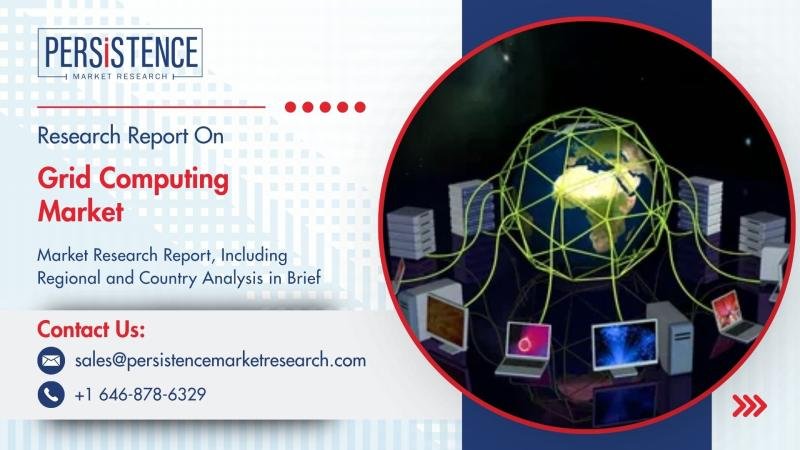✅Rising Digital Transformation and Cloud Integration to Drive Grid Computing Market Expansion
According to the latest study by Persistence Market Research, the grid computing market is poised for strong growth, reaching unprecedented levels by 2032. With increasing reliance on distributed computing resources and surging demand for high-performance computing (HPC) capabilities across sectors like finance, healthcare, research, and energy, the market is witnessing significant traction. Grid computing enables the pooling of geographically dispersed computational power to solve large-scale data processing and analytical challenges, driving its adoption across industries that demand real-time insights, flexibility, and cost optimization.
The market is gaining momentum due to the rising need for efficient computing infrastructure, especially in AI, big data analytics, and cloud-based services. Financial institutions and scientific research bodies are leveraging grid computing to accelerate complex simulations and large-scale modeling. In terms of segment dominance, utility computing leads the grid computing deployment models due to its cost-efficiency and scalable infrastructure. Regionally, North America is the frontrunner in this market, attributed to the strong presence of technology firms, massive cloud infrastructure adoption, and early integration of advanced computing technologies across government and enterprise sectors.
Get a Sample PDF Brochure of the Report (Use Corporate Email ID for a Quick Response): https://www.persistencemarketresearch.com/samples/18496
✅Key Market Insights
➤ Growing use of grid computing in life sciences and research for genome mapping and clinical simulations.
➤ Cloud integration with grid computing is enhancing data accessibility and real-time processing capabilities.
➤ Utility-based grid computing is reducing CAPEX for small and medium enterprises, enabling wider market adoption.
➤ North America continues to lead the market with strong technological infrastructure and R&D spending.
➤ Cybersecurity advancements are making grid systems more robust, thus increasing confidence in cross-enterprise resource sharing.
✅What is grid computing and why is it important?
Grid computing is a distributed computing model that connects multiple computer systems and resources across various locations to work on a single task or application. It enhances computing performance, accelerates processing, and reduces idle time by utilizing otherwise underused systems. Grid computing is important because it provides a cost-effective and scalable solution for handling massive datasets and complex computations. It is widely used in scientific research, finance, and data-intensive industries where high-speed data processing and flexibility are critical for innovation, modeling, and decision-making.
✅Market Dynamics
Market Drivers:
One of the main drivers of the grid computing market is the growing need for distributed data processing across sectors such as BFSI, healthcare, and energy. The increasing adoption of AI and ML algorithms requires significant computing power, which grid infrastructure can support at scale. Moreover, government initiatives to improve data governance and implement smart infrastructure are propelling demand for advanced computing networks.
Market Restraining Factor:
Despite its advantages, the market faces challenges due to complexities in managing distributed networks, concerns over data privacy, and integration hurdles with legacy IT systems. Lack of standardized protocols and skilled professionals for managing grid environments also restrain wider adoption, especially in small and mid-sized enterprises.
Key Market Opportunity:
A major opportunity lies in the convergence of grid computing with edge computing and IoT frameworks. This integration can facilitate real-time processing of large datasets at lower latency and cost. Additionally, increased investment in smart cities and autonomous systems offers a promising landscape for grid computing solutions that need to process data from multiple decentralized sources.
✅Market Segmentation
The grid computing market is segmented based on component, deployment model, and end-user industry. By component, the market is divided into hardware, software, and services. Hardware includes servers, data centers, and networking equipment essential for grid setup, while software comprises middleware and grid management tools. Services include integration, maintenance, and consulting. Among these, the software segment holds a dominant position due to its role in orchestrating grid nodes, job scheduling, and secure resource allocation.
Based on deployment model, the market is segmented into dedicated grid and utility grid. Dedicated grids are typically used by large enterprises or research organizations for proprietary tasks, offering high performance but at higher costs. In contrast, utility grids are gaining wider adoption due to their flexible, pay-as-you-go structure, which appeals to SMEs and institutions with fluctuating workload demands. Key end-user industries include BFSI, healthcare, government, energy, IT & telecom, and education/research. The education and research sector has emerged as a leading adopter due to its constant demand for high-speed simulation and modeling tools, while BFSI and healthcare are fast-growing segments owing to the increasing complexity of data analytics and security requirements.
✅Regional Insights
Geographically, North America dominates the grid computing market, primarily due to advanced IT infrastructure, early adoption of high-performance computing (HPC) platforms, and strong presence of leading tech firms. The United States, in particular, has made notable investments in data centers, cloud grids, and AI research labs that rely heavily on distributed computing. Furthermore, collaboration between private firms and government agencies for defense and research operations boosts the regional market.
Europe follows closely, with countries like Germany, the UK, and France adopting grid computing in healthcare, manufacturing, and academic institutions. Asia Pacific is emerging as the fastest-growing region, led by rapid digitalization in countries such as China, India, and Japan. Expanding industrial base, growing e-governance programs, and focus on smart infrastructure development contribute to market growth. Meanwhile, Latin America and the Middle East & Africa present long-term opportunities due to increasing IT adoption and smart city initiatives.
✅Competitive Landscape
The grid computing market is moderately competitive, with companies focusing on partnerships, innovations, and cloud integration to gain market advantage. Market leaders are also emphasizing open-source grid software, cybersecurity enhancements, and resource scalability.
✅Company Insights
✦ IBM Corporation
✦ Oracle Corporation
✦ Microsoft Corporation
✦ Fujitsu Limited
✦ Altair Engineering Inc.
✦ Amazon Web Services, Inc.
✦ Hewlett Packard Enterprise Development LP
✦ Dell Technologies Inc.
✦ Advanced Micro Devices, Inc.
✦ Ansys, Inc.
✦ Univa Corporation
For Customized Insights on Segments, Regions, or Competitors, Request Personalized Purchase Options @ https://www.persistencemarketresearch.com/request-customization/18496
✅Key Industry Developments
Recent developments in the grid computing market reflect a growing emphasis on interoperability and hybrid integration. IBM has been leading the charge in building grid computing frameworks for financial and research sectors through its cloud-native platforms. Similarly, AWS and Microsoft Azure are focusing on expanding their utility grid offerings, allowing enterprises to harness unused computing power across geographies for complex data processing.
In addition, Fujitsu and Oracle have announced strategic collaborations with academic institutions to build research grids for genomic studies and predictive modeling. These projects leverage AI-integrated grid environments to accelerate data interpretation, especially in climate studies and pharmaceutical innovation. Market players are also exploring grid-based blockchain validation mechanisms to enhance security in decentralized systems.
✅Innovation and Future Trends
The future of the grid computing market lies in cloud-grid convergence, where cloud service providers offer grid computing as-a-service (GCaaS), allowing businesses to access scalable computing resources without large capital investments. This model will be particularly attractive to startups, research labs, and SMEs. Innovations in containerization and virtualization are also making grid deployment easier and more flexible, allowing dynamic resource allocation based on task priority.
Another transformative trend is the integration of AI, quantum computing, and edge networks with grid architecture. This fusion allows for highly intelligent task distribution, enhanced resource utilization, and predictive workload balancing. As global enterprises become increasingly data-dependent, grid computing will evolve into a critical infrastructure layer that supports real-time analytics, secure collaboration, and autonomous operations across decentralized environments.
✅Explore the Latest Trending “Exclusive Article” @
• https://techxpresstoday.wordpress.com/2025/07/03/pedestrian-entrance-control-systems-market-demand-rising-with-urban-security-needs/
• https://medium.com/@apnewsmedia/pedestrian-entrance-control-systems-market-share-by-leading-companies-5be92142b953
• https://vocal.media/stories/pedestrian-entrance-control-systems-market-growth-trends-and-future-outlook
• https://apsnewsmedia.blogspot.com/2025/07/automotive-camera-cleaning-system.html
• https://www.manchesterprofessionals.co.uk/article/information-technology/96656/pedestrian-entrance-control-systems-market-overview-and-key-insights
✅Contact Us:
Persistence Market Research
G04 Golden Mile House, Clayponds Lane
Brentford, London, TW8 0GU UK
USA Phone: +1 646-878-6329
UK Phone: +44 203-837-5656
Email: sales@persistencemarketresearch.com
Web: https://www.persistencemarketresearch.com
✅About Persistence Market Research:
At Persistence Market Research, we specialize in creating research studies that serve as strategic tools for driving business growth. Established as a proprietary firm in 2012, we have evolved into a registered company in England and Wales in 2023 under the name Persistence Research & Consultancy Services Ltd. With a solid foundation, we have completed over 3600 custom and syndicate market research projects, and delivered more than 2700 projects for other leading market research companies’ clients.
Our approach combines traditional market research methods with modern tools to offer comprehensive research solutions. With a decade of experience, we pride ourselves on deriving actionable insights from data to help businesses stay ahead of the competition. Our client base spans multinational corporations, leading consulting firms, investment funds, and government departments. A significant portion of our sales comes from repeat clients, a testament to the value and trust we’ve built over the years.
This release was published on openPR.



